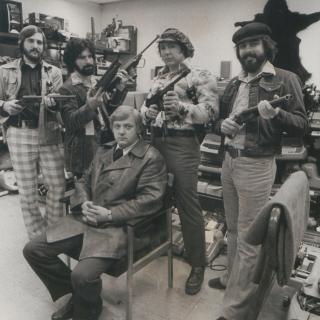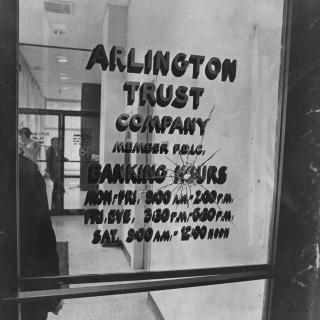The Human Kindness Day That Wasn't
Promote neighborly goodwill and the arts with a free concert on the National Mall? It sounded like a great idea to Stevie Wonder when he was approached by Compared to What, Inc. a non-profit D.C. arts education group in 1975. As organizer Carol Kirkendall remembered, “One of the motivations for Stevie was a political one. He was motivated to change the world and to fight the injustices of how young black people were being raised in the city. He knew what the arts could mean to those young people.”[1]
The concert was the highlight of the fourth annual Human Kindness Day festival on May 10, 1975. The festivities began with an 8 am “Run for Human Kindness” in which dignitaries and members of the Washington Bullets and Redskins joined members of the community for a jog through the city. On the Washington Monument grounds, Compared to What set up art displays and demonstrations, while D.C. Schools Superintendent Barbara Sizemore handed out awards to children who had entered art and writing contents. Then the music started on stage at the nearby Sylvan Theatre at noon. Opening acts including Graham Central Station warmed up the crowd for Stevie Wonder, who took the stage around 6 pm.
“People came singly, doubly and with family or neighborhood groups. There were hundreds of picnic hampers and six-pack cartons. Some smoked marijuana openly, others attempted to be more discriet [sic], but the odor drifted unmistakably over the crowd.”[2]
In other words, the concert started out like pretty much any other rock show. The sun was shining and the mood was positive. An estimated 125,000 people swayed to the sound of the music.
As the afternoon progressed, however, the scene changed dramatically. Witnesses recounted seeing “roving bands” of teenagers causing disturbances in the crowd.[3] Much of the crime came in the form of purse snatching, wherein victims were chosen seemingly at random. But an alarming number of incidents turned violent and, it soon became clear, were possibly racially motivated. Multiple witnesses and victims described groups of black teenagers targeting white attendees. As Emelda Southerland, a black Washingtonian who had her camera stolen, told The Washington Post, “It was definitely ‘get the white folks’ at the end,” before adding, “I don’t think Human Kindness Day is possible.”[4]
Park police received reports of 211 robberies, a shooting, four larcenies and seven other assaults.[5] Hospitals treated 150 people for injuries.[6] The most serious incident occurred when Steven Laine, director of public affairs for the Secretary of Agriculture was attacked and stabbed in the right eye. When no one came to his aid, he stumbled his way to a first aid tent and was rushed to George Washington University Hospital, where doctors informed him that they couldn’t save his eye.
In the aftermath of the concert, city officials and community members alike struggled to explain what had happened – and why. Malik Edwards, a community organizer from Southeast Washington described a snowball effect at the show. “It was a case of a small group getting away with chasing whitey through the crowd. Then, when it got big and they got angry, no one wanted to try to stop them.”[7]
The mayor’s office questioned the preparedness of the Park Police and a Washington Post editorial called for the Park Service to outlaw rock concerts on the Mall on the basis that they “seem to breed a special kind of trouble that is hard to control.”[8]
Meanwhile, Rep. Ronald V. Dellums (D – CA), who sat on Compared to What’s board, lambasted the media for “inept, inadequate, narrow, one-sided and racist reporting.” He charged that “the press, which is dominated by whites, you played up the racial angle…. I’m not defending the acts of violence, but they were reported in a context that was irresponsible… that’s not journalism.”[9]
The Washington Star’s Pulitizer Prize-winning columnist Mary McGrory chided all sides, writing “the postmortems have centered on irrelevancies.” The real issue, she said, was Washington’s tense racial climate marked by “fear and hatred which run like a poisoned river under the surface.”[10] This climate, McGrory lamented, was seldom acknowledged publicly: “Race relations in this city might be perfect for all they figure in public discussion.”
At least one person was willing to start the conversation. Addressing a city-wide conference on juvenile delinquency a few days after the ill-fated concert, Howard University psychiatrist Dr. Alyce C. Gullattee put the focus on larger issues of inequality, urging officials, “Don’t blame it on the children. Don’t blame it on the people. Blame it on the system.”[11]
The system, she argued, was a cascade of policies and programs – such as urban renewal – that had been developed by primarily white policymakers to ensure that whites remained securely atop the socio-economic ladder in America. This system alienated black youth and caused “anger, rage and hostility.”[12]
“The summer is coming,” she warned the audience. “It is hot and we need money for programs for our children. Otherwise, what we saw the other day is just a small indication of what is going to happen nationwide.”[13] As she pushed for governmental intervention, Dr. Gullattee also called for black parents and community leaders to give better guidance to youth at home.
As one might imagine, Dr. Gullattee’s stance was applauded in some circles and roundly criticized in others. But it’s safe to say that her comments served to illustrate the divisions that were present in the D.C. community.
Footnotes
- ^ Richards, Chris, “Meet the hippie and the beatnik who orchestrated D.C. aural history,” The Washington Post, 31 July 2015.
- ^ Feaver, Douglas B. and Alice Bonner, “Scattered Acts of Violence Mar Human Kindness Day Celebration,” The Washington Post, 11 May 1975: A4.
- ^ Ibid.
- ^ Novitski, Joseph, “The Cruel Side of ‘Kindness’: Butz Aide Loses Eye in Attack Near Monument,” The Washington Post, 12 May 1975: A1.
- ^ Feaver, Douglas B. and Alice Bonner, “Scattered Acts of Violence Mar Human Kindness Day Celebration,” The Washington Post, 11 May 1975: A4.
- ^ Novitski, Joseph, “White Dominance Hit,” The Washington Post, 15 May 1975: B1.
- ^ Novitski, Joseph, “Inadequate Controls Blamed in ‘Kindness Day’ Violence,” The Washington Post, 14 May 1975: A26.
- ^ “The Violence on the Monument Grounds,” The Washington Post, 13 May 1975: A18.
- ^ Gay, Lance, “Unkind Acts of ’75 to Result in Smaller ’76 Kindness Day,” The Washington Star, 14 May 1975: A-4.
- ^ McGrory, Mary, “Racial Ills Cry Out for Attention,” The Washington Star, 16 May 1975: A3.
- ^ Novitski, Joseph, “White Dominance Hit,” The Washington Post, 15 May 1975: B1.
- ^ “In Huddle on Human Kindness,” Washington Afro American, 20 May 1975: 1.
- ^ Novitski, Joseph, “White Dominance Hit,” The Washington Post, 15 May 1975: B1.





![Sketch of the mythical fuan by Pearson Scott Foresman. [Source: Wikipedia]](/sites/default/files/styles/crop_320x320/public/2023-10/Goatman_Wikipedia_Faun_2_%28PSF%29.png?h=64a074ff&itok=C9Qh-PE1)












